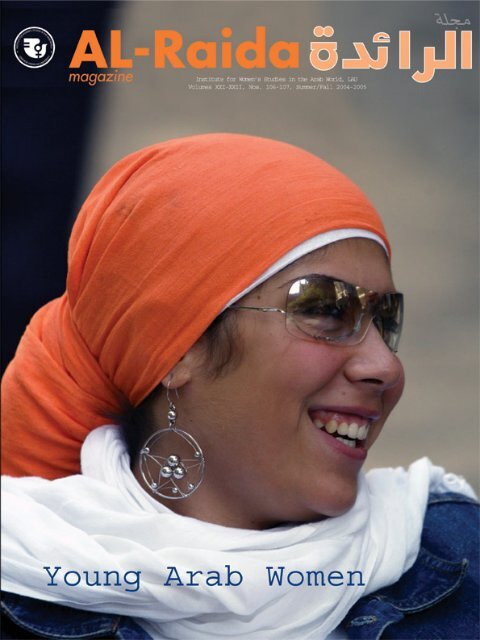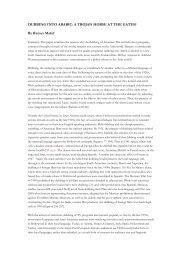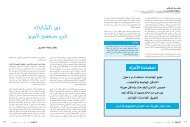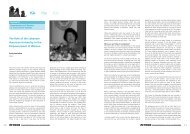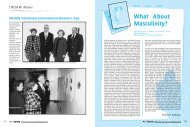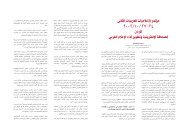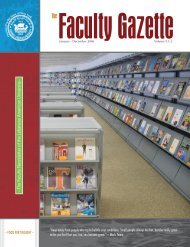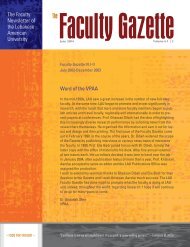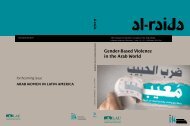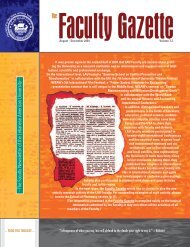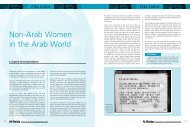IWSAW News - Lebanese American University
IWSAW News - Lebanese American University
IWSAW News - Lebanese American University
You also want an ePaper? Increase the reach of your titles
YUMPU automatically turns print PDFs into web optimized ePapers that Google loves.
ABOUT <strong>IWSAW</strong><br />
The Institute for Women’s Studies in the Arab<br />
World (<strong>IWSAW</strong>) was established in 1973 at the<br />
<strong>Lebanese</strong> <strong>American</strong> <strong>University</strong> (formerly Beirut<br />
<strong>University</strong> College). Initial funding for the Institute<br />
was provided by the Ford Foundation.<br />
OBJECTIVES: The Institute strives to serve as a data<br />
bank and resource center to advance a better understanding<br />
of issues pertaining to Arab women and<br />
children; to promote communication among individuals,<br />
groups and institutions throughout the<br />
world concerned with Arab women; to improve the<br />
quality of life of Arab women and children through<br />
educational and development projects; and to<br />
enhance the educational and outreach efforts of the<br />
<strong>Lebanese</strong> <strong>American</strong> <strong>University</strong>.<br />
PROJECTS: <strong>IWSAW</strong> activities include academic<br />
research on women, local, regional and international<br />
conferences; seminars, lectures and films; and<br />
educational projects which improve the lives of<br />
women and children from all sectors of <strong>Lebanese</strong><br />
society. The Institute houses the Women’s<br />
Al-Raida is published quarterly by the Institute for<br />
Women’s Studies in the Arab World (<strong>IWSAW</strong>) of the<br />
<strong>Lebanese</strong> <strong>American</strong> <strong>University</strong> (LAU), formerly<br />
Beirut <strong>University</strong> College, P.O. Box 13-5053,<br />
Chouran Beirut, 1102 2801 Lebanon; Telephone: 961<br />
1 867618, ext. 1288; Fax: 961 1 791645. The<br />
<strong>American</strong> address of LAU is 475 Riverside Drive,<br />
Room 1846, New York, NY 10115, U.S.A.;<br />
Telephone: (212) 870-2592; Fax: (212) 870-2762.<br />
PURPOSE AND CONTENT: Al-Raida’s mission is to<br />
enhance networking between Arab women and<br />
women all over the world; to promote objective<br />
research of the conditions of women in the Arab<br />
world, especially conditions related to social change<br />
and development; and to report on the activities of the<br />
<strong>IWSAW</strong> and the <strong>Lebanese</strong> <strong>American</strong> <strong>University</strong>.<br />
ABOUT AL-RAIDA<br />
Documentation Center in the Stoltzfus Library at<br />
LAU. The Center holds books and periodicals. The<br />
Institute also publishes a variety of books and pamphlets<br />
on the status, development and conditions of<br />
Arab women, in addition to Al-Raida. Eight children’s<br />
books with illustrations, and two guides, one<br />
of which specifies how to set up children’s libraries,<br />
and the other which contains information about producing<br />
children’s books, have also been published<br />
by <strong>IWSAW</strong>. In addition, the Institute has also created<br />
income generating projects which provide<br />
employment training and assistance to women from<br />
war-stricken families in Lebanon. The Institute has<br />
also devised a “Basic Living Skills Project” which<br />
provides a non-formal, integrated educational program<br />
for semi-literate women involved in development<br />
projects. Additional <strong>IWSAW</strong> projects include<br />
The Rehabilitation Program for Children’s Mental<br />
Health; Teaching for Peace; and the Portable<br />
Library Project. The latter project was awarded the<br />
Asahi Reading Promotion Award in 1994. For<br />
more information about these or any other projects,<br />
write to the Institute at the address provided.<br />
Each issue of Al-Raida features a File which focuses<br />
on a particular theme, in addition to articles, conference<br />
reports, interviews, book reviews and art news.<br />
REPRINT RIGHTS: No unsigned articles may be<br />
reprinted without proper reference to Al-Raida.<br />
Permission to reprint signed articles must be obtained<br />
from the <strong>IWSAW</strong>.<br />
SUBMISSION OF ARTICLES: We seek contributions<br />
from those engaged in research, analysis and study of<br />
women in the Arab world. Contributions should not<br />
exceed ten double-spaced typed pages. Please send a<br />
hard copy and a diskette. We reserve the right to edit<br />
in accordance with our space limitations and editorial<br />
guidelines. Submissions will not be published if<br />
they have been previously published elsewhere.<br />
S U B S C R I P T I O N<br />
THE ANNUAL SUBSCRIPTION FEE FOR AL-RAIDA IS US $ 30. SUBSCRIPTIONS BEGIN IN JANUARY AND END IN DECEMBER.<br />
Editor: Mona Fayad<br />
Assistant Editor: Myriam Sfeir<br />
Copy Editor: Debbie Lovatt<br />
Designer: Zouheir Debs<br />
Editorial Board:<br />
Samira Aghacy - LAU<br />
Sami Baroudi - LAU<br />
Arda Ekmekji - Haigazian<br />
Najla Hamadeh - Bahithat<br />
Mona C. Khalaf - <strong>IWSAW</strong><br />
Lynn Maalouf - Journalist<br />
Eugene Sensenig Dabbous - NDU<br />
Fawwaz Traboulsi - LAU<br />
International Advisory Board:<br />
Fadia Faqir - Writer<br />
Mary Kawar - ILO<br />
Adele Khudr - UNICEF<br />
Ann Lesch - AUC<br />
Al-Raida<br />
The quarterly journal<br />
of the Institute for Women’s Studies<br />
in the Arab World<br />
<strong>Lebanese</strong> <strong>American</strong> <strong>University</strong><br />
P.O. Box 13-5053<br />
Chouran, Beirut,<br />
1102 2801 Lebanon<br />
Telephone: 961 1 867618, ext.1288<br />
Fax: 961 1 791645<br />
e-mail: al-raida@lau.edu.lb<br />
Institute for Women’s Studies in the Arab World, LAU<br />
Volume XXI-XXII, Nos. 106-107, Summer/Fall 2004-2005<br />
Editorial 2<br />
Opinion 5<br />
Research <strong>News</strong> 7<br />
Quote / Unquote 8<br />
<strong>News</strong>Briefs 9<br />
<strong>IWSAW</strong> <strong>News</strong> 10<br />
File<br />
File Intro 11<br />
Arab Adolescent Girls 12<br />
Adolescence in Arab Communities 28<br />
The <strong>Lebanese</strong> Youth 33<br />
What Moves the Young? 38<br />
Cross-Generation Sexual Abuse 45<br />
Jordan: Young, Single and Employed 50<br />
United Arab Emirates: Educating Ms. Fatima 56<br />
Egypt: ‘Urfi marriage 64<br />
Lebanon: |Adolescents and Puberty 70<br />
Women's Path to Independence in Syria 74<br />
Bringing Sports and Opportunities 77<br />
to Girls in Rural Egypt<br />
Morocco: Children and Teaching in Rural Areas 84<br />
Reducing Early Marriage in Yemen 86<br />
Young Media Women 88<br />
Poor Women’s Empowerment 92<br />
Round Table 94<br />
Book Review<br />
TABLE OF CONTENTS<br />
Persepolis 96<br />
The Mind Complains and the Body Suffers 99<br />
The Diary of a Frightened Girl 103<br />
Cover - Picture Credit: Ayman Mroueh
Editorial<br />
Why an Issue on Young<br />
Arab Women?<br />
Mona Fayad<br />
Professor, Psychology Department, Human Sciences and Literature Faculty, <strong>Lebanese</strong> <strong>University</strong><br />
Adolescence is considered one of the most essential phases in<br />
the life of a person; it separates between two extremely vital<br />
phases in one’s life, namely childhood and adulthood. Most<br />
studies all over the Arab world show that the average percentage<br />
of youth below the age of 20 has reached one third<br />
of the population. This implies that attention to this age group<br />
is highly essential because of the demographic weight it represents<br />
– over and above the fact that adolescents are going<br />
to be responsible for the future of the Arab world in the coming<br />
years. Herein lies the importance of concentrating on this<br />
category in order to examine its characteristics, attributes and<br />
problems. Moreover, focusing on the youth is of essence given<br />
that UNESCO’s 2003 report indicates that the number of illiterate<br />
people in the Arab world added up to 70 million, of<br />
whom two thirds are women and girls. Not to mention the 40<br />
million unemployed individuals who mostly belong to the<br />
youth category. Thus, there is an urgent need to work with<br />
and for youth (particularly girls/women) in order to improve<br />
their status. This will reflect positively on the future of the<br />
region. How are teenagers faring in the Arab world? What do<br />
they think of and what are their aspirations? Who are their<br />
role models? What is their position vis-à-vis marriage, work<br />
and reproduction? Researchers will benefit from the data collected<br />
during the fieldwork for the study on Arab Adolescent<br />
Girls prepared by the Center for Arab Women for Training and<br />
Research in Tunis . Below are several of the findings arrived at:<br />
Late Marriage Age<br />
Numerous changes are taking place all over the Arab world,<br />
especially regarding the status of women. Several reports from<br />
various Arab countries unanimously indicate a delay in the age<br />
of marriage. In Morocco, and based on the reports of the<br />
demographic survey conducted, one can conclude: “The first<br />
age of marriage is mounting. In 1960 it was 18 years but<br />
nowadays it is 27 years. Moreover, the use of contraception<br />
rose from 8% in the sixties to 60% at present.” Late marriage<br />
is on the rise in Tunisia; it amounted to 29.2 years for women<br />
and 32.5 years for men, i.e. marriages are contracted at an<br />
average of 16 years after puberty. Late marriage is also<br />
increasing in Lebanon where the average age of marriage is<br />
29 years based on the official statistics yielded in the 1996<br />
study conducted by the Ministry of Social Affairs.<br />
It is worth noting that Yemen is the only country in the sample<br />
where an early marriage age among men and women is<br />
abundant. Despite the fact that a qualitative improvement has<br />
occurred in the average age at first marriage, namely 23.73<br />
years for both sexes (25.35 for males and 21.94 for females).<br />
Yet, the reality of the matter is that early marriage is still a<br />
problem within Yemeni families. Furthermore, an early marriage<br />
age is still a problem in the Gulf countries. Even though<br />
Bahrain managed to attain an increase in the average age of<br />
marriage, the improvement is a slight one, namely 21.9 for<br />
the year 1990 and 22.3 for the year 2000. One of the explanations<br />
why early marriage age is required and sustained is<br />
the fact that the countries of the Gulf in general are still in<br />
favor of segregation between the sexes.<br />
Celibacy is no longer viewed as something out of the ordinary<br />
in the Arab world. Hence, if someone is celibate that does not<br />
necessarily imply that he/she is a homosexual. Nowadays,<br />
there is a new trend that views marriage in a critical and speculative<br />
manner. This is due to the fact that many of the family<br />
problems surrounding marriage have started to surface. Not<br />
to mention the latest developments that have altered the role<br />
of the family on the one hand and the requirements of the<br />
individual within the family on the other.<br />
The Meaning of Marriage and Securing the Parents’ Approval<br />
Over and above the delay that has occurred in the age of marriage,<br />
the Tunisian survey indicates a change in the patterns of<br />
marriage and the way it is now contracted. We notice that<br />
endogamous marriages are lessening with each coming<br />
decade. This signifies a decrease in the matchmaking efforts<br />
exerted by family members eager to marry off girls. In 1971,<br />
89% of marriages were endogamous whereas in the last<br />
decade the number fell to 72%. This implies that the new<br />
generation is more inclined to view marriage as a personal<br />
matter rather than a communal affair where the final decision<br />
is in the hands of the family. This trend also highlights the<br />
emergence of the individual who is an independent entity and<br />
relies on his/her judgment and opinion in his/her personal<br />
decisions. Love and understanding between the couple are<br />
the determinants in such marriages and not the interest of the<br />
family. Yet, it is worth mentioning that marriage, in traditional<br />
societies, is usually viewed as a communal and social matter<br />
determined by the interests of the two families involved.<br />
Based on the findings one could conclude that there are some<br />
who oppose the concept of marriage and others who impose<br />
conditions prior to getting married. Many girls refuse the idea<br />
of marriage all together if these conditions are not fulfilled.<br />
Moreover, marital and familial problems might discourage girls<br />
from getting married or fantasizing about marriage – something<br />
that is expected from teenagers. Yet, most of them think<br />
that marriage is inevitable and “nice,” especially when love is<br />
involved. What becomes apparent is that love is of essence. Yet,<br />
as I mentioned earlier, girls nowadays have certain conditions<br />
that ought to be fulfilled if they are to accept the suitor. Among<br />
the requirements are reaching an agreement on who is in<br />
charge, and on the level of freedom and independence the girl<br />
will enjoy especially if she was raised within an educated or<br />
urban family or sometimes both. Some girls require their future<br />
husbands to be cooperative. One of the respondents refused to<br />
follow in the footsteps of her mother who used to exhaust herself<br />
due to her double burden, namely working inside and outside<br />
the home. These questions remain: Are women less eager<br />
to compromise given that they no longer fear remaining spinsters?<br />
Besides, how does that affect demographic growth?<br />
How does this affect the family?<br />
Motherhood<br />
Opinions differ among teenagers when discussing the issue of<br />
motherhood. Yet, none of the girls in the sample was as affirmative<br />
in their refusal to conceive as Ashraf who fails to see<br />
himself as a father. Even though Rafif used to see eye to eye<br />
with Ashraf when she was younger, she recently started contemplating<br />
the idea. She has no idea how many children she<br />
wants; all she knows is that she wants a lot of them. Reem,<br />
who was barely 15 when she was interviewed, admitted that<br />
the idea did not even cross her mind. She asserts: “Every<br />
young person, when asked, might tell you they don’t want to<br />
get married and have children. Yet, at the end of the day they<br />
all do it. As far as I am concerned I really don’t know.”<br />
Motherhood is still viewed, in poor environments, as an<br />
absolute necessity. Zeinab affirms: “Motherhood transforms a<br />
woman into a mature and balanced individual.” However,<br />
there were girls among the respondents who knew beforehand<br />
exactly how many children they wanted to have: “I do<br />
not want many children, one or two is enough.”<br />
Work Inside and Outside the Home<br />
The contrast is striking when talking about domestic work,<br />
especially among youth of different social and educational<br />
backgrounds. No differences were detected on the basis of<br />
religion or place and area of residence (urban/rural). Girls coming<br />
from poor families accept the traditional division of labor<br />
between the sexes. They rarely question the unfairness and<br />
only one of the respondents asked: “Why doesn’t he serve<br />
himself?” Educated girls, whether they belong to the urban<br />
milieu or to the rural, affluent and educated class, demand to<br />
be treated equally, whereas most poor girls have no notion of<br />
what equality means or stands for.<br />
Most teenagers in the sample who pursue their education and<br />
are in their secondary school years are adamant about pursuing<br />
their higher education. Moreover, they are eager to work<br />
and get married in the future. As far as the poor teenagers are<br />
concerned most of them left school at an early age. Despite<br />
the fact that they dream of working, it is all “talk” given that<br />
they are not working hard enough to realize their dreams nor<br />
are they prepared for such a step. It is worth noting that some<br />
of the poor girls in the sample pitied women who worked outside<br />
the home. Their position is influenced by the traditional<br />
and agricultural societies they belong to and that made it possible<br />
for women to dispense of the hard work they used to<br />
carry out in the fields.<br />
The position of boys vis-à-vis housework is still vague and<br />
unresolved. In theory boys belonging to educated and well-todo<br />
families refuse the traditional division of labor and are<br />
more willing to assist with the housework. For example,<br />
Ashraf is for total equality between the sexes, yet, he preaches<br />
more than he practices. And there are some men who complain<br />
about women’s much exaggerated need “to be equal<br />
with men.”<br />
Feeling Monitored and Discrimination Against the Sexes<br />
During Puberty<br />
Girls, in general, put up with being monitored and endure<br />
strict surveillance by their parents. Based on our findings, most<br />
of the arguments and clashes that arise within the family stem<br />
from the way girls dress and their desire to go out. Most<br />
teenagers argue with parents on issues regarding freedom of<br />
movement, yet boys go out more freely and parents are more<br />
lenient and tolerant with sons. Moreover, girls are often questioned<br />
about the nature of their relationships with boys.<br />
Hence, we find that rural families watch their children closely<br />
and are more overprotective in general. The family’s economic<br />
status plays an important role in increasing or decreasing<br />
the meddling of parents. Besides, belonging to a conservative<br />
and traditional family is another factor that affects the youth’s<br />
mobility and freedom. For instance, Rani, who belongs to an<br />
urban conservative family, is closely watched; however, he<br />
admits it is bearable. Whereas girls from popular and poor<br />
backgrounds are severely monitored, they are not allowed to<br />
go out unaccompanied and are prohibited from wearing<br />
improper and indecent clothes. Hence, most of the disputes<br />
and conflicts are related to freedom of movement and dress,<br />
and occur mostly in rural areas that are generally very conservative<br />
– like most Arab societies.<br />
Body, Appearance and Sports<br />
Based on our research we recognized that most boys take care<br />
of their physical appearance, strive to be physically fit and<br />
2 Volume XXI-XXII, Nos. 106-107, Summer/Fall 2004-2005<br />
Volume XXI-XXII, Nos. 106-107, Summer/Fall 2004-2005 3
Editorial<br />
Opinion<br />
pay attention to the way they dress. Most often they realize<br />
that they don’t need to diet, all they need is to work out in<br />
order to remain physically fit. Through sports men aspire to<br />
acquire the perfect figure and rarely do men contemplate<br />
plastic surgery. Being slim and fit are necessities among<br />
teenagers, be they male or female. However, one has to<br />
admit that females are more obsessed with their weight<br />
than men. Moreover, unlike women who often diet to attain<br />
the perfect figure, men concentrate on sports and prefer to<br />
exercise. Many of the girls interviewed admitted that they<br />
do not eat dinner so as not to put on weight. Besides, a lot<br />
are thin and fit, yet they still insist on taking extra care of<br />
their figure. Nadine is the only plump girl who is content<br />
with her figure and has accepted the fact that she is overweight.<br />
Her brother, on the other hand, often asks her to<br />
pay more attention to her weight problem and encourages<br />
her to diet.<br />
Role Models<br />
A father who is successful and holds a good job such as an<br />
army officer or a university professor, is usually considered a<br />
role model or hero by his son. Sometimes a maternal uncle,<br />
usually living abroad, who is a successful businessman or an<br />
athlete, may also serve as a teenager’s idol or hero. For girls,<br />
mothers are their role models especially if they belong to<br />
popular and poor backgrounds. Yet, most of the time a<br />
teenager’s role model is a teacher. Herein lies the importance<br />
of the school and the faculty in the life of the teenager.<br />
Thus, it is imperative to provide education for all and to train<br />
the faculty thoroughly. Moreover, special emphasis ought to<br />
be given to the choice of schoolbooks and to sex education.<br />
Yet, based on the research undertaken we realized that in<br />
poor backgrounds, the youth tend to identify with a famous<br />
female/male singer. The massive proliferation of television<br />
programs, artistic and musical in nature, that have burst<br />
upon the Arab world drawing huge audiences is worth<br />
investigating given that Arabs from different backgrounds<br />
and communities spend their evenings glued to their television<br />
sets watching these programs. What is the purpose<br />
behind such programs? Why do the youth of both sexes<br />
pass time watching them? Is it because of the loneliness<br />
they suffer? Or because of the frustration that has resulted<br />
from the many defeats the Arabs have experienced? Or is it<br />
because of the absence of hope, or because of the prevalence<br />
of autocratic regimes? If some of these programs represent<br />
what is presently “fashionable” in art and singing,<br />
and if we agree that a few enjoy an average artistic level<br />
then soon they will become the norm. Every new trend in<br />
society raises a lot of objections at first; however, with time<br />
it becomes accepted and develops into a characteristic of<br />
the period. (Let us not forget that the classical songs sung<br />
by Abdel Haleem Hafez and some of his contemporaries,<br />
such as Shadia, were called “taqateek” (or very light popular<br />
music) in the beginning given that the songs were considered<br />
light music in comparison to tarab or authentic Arab<br />
music.) The trend nowadays is to invest in programs that<br />
host the latest “clip singers” who, instead of capitalizing on<br />
their talent, take advantage of their physical attraction to<br />
promote themselves. These artists are bold to the point of<br />
vulgarity. Instead of art the audience is entertained with<br />
flesh. Pornography and the willingness to strip have<br />
replaced talent. The question remains: What do these programs<br />
represent for the viewer? What do these phenomena<br />
symbolize? Do these programs really represent the ideal for<br />
the youth in their behavior and aspirations?<br />
Are the youth in the Arab world divided into those who view<br />
light artistic programs and others who follow religious programs<br />
aired on the satellite channels? The latter programs also<br />
have their heroes and heroines, such as Amr Khaled who promotes<br />
the nominal religious symbols, namely wearing the veil<br />
yet dressing in modern clothes, and praying and fasting yet<br />
putting into practice all aspects of modernization.<br />
Friendship Between the Sexes<br />
The higher one climbs the social ladder, the more recurrent<br />
the interaction between the sexes and the more probable<br />
and possible the friendship between them. Friendship<br />
between the sexes is a privilege only educated and affluent<br />
girls enjoy. Poor girls are more reserved and unapproachable<br />
when discussing the subject. Sometimes just mentioning the<br />
subject is frowned upon.<br />
Music and Reading<br />
Listening to music is a youth distraction par excellence and<br />
is sought universally. Youth listen to all sorts of music<br />
depending on age and social class. Yet, one must admit that<br />
music nowadays is part and parcel of a teenagers’ life, with<br />
some unable to imagine life without it. Unlike music, reading<br />
is practiced by the select few and is seen as an obligation<br />
by most young people. It is crucial to investigate the<br />
reasons behind such a serious crisis and work on finding a<br />
rapid and serious solution if we are hoping to improve our<br />
deteriorating position on the international scene.<br />
Violence<br />
Domestic violence was detected as a problem the young suffer<br />
from. The violence ranges from verbal to psychological to<br />
physical abuse. Some of the young people interviewed<br />
admitted that domestic violence existed in their families but<br />
it was mostly verbal violence. Among certain families battery<br />
was also used when the respondents were young. Yet, many<br />
affirmed that the beatings lessened with the passage of time<br />
and became practically non-existent at the onset of puberty.<br />
However, such is not always the case given that three cases<br />
were detected where battery and abuse were more prevalent<br />
and consistent than the rest of the cases. It is worth<br />
mentioning that psychological and verbal abuse is mostly<br />
prevalent among poor families. Moreover, mothers more<br />
than fathers make use of verbal abuse and upper class<br />
fathers do not employ violence.<br />
Translated by Myriam Sfeir<br />
Miss Lebanon<br />
or Miss Habalon * :<br />
Beauty Queens<br />
and Reality Television<br />
Riad Kobaissi<br />
Journalist<br />
Is it reality television or realistic television? This question<br />
demands an urgent and necessary answer when “our<br />
beauty queens” become the subject matter of such television,<br />
especially since the beauty queen no longer represents<br />
a fantasy creature, a flawless role model for<br />
young women in terms of her behavior, actions, and<br />
activities sponsoring the disabled, children, and elderly.<br />
Instead, our beauty queen has become a topic of inspection,<br />
at least before she became a beauty queen. Before<br />
becoming a queen, she underwent a difficult experience<br />
with her fellow candidates. She underwent that experience<br />
on air and on live broadcast on a daily basis 24<br />
hours a day. She and 15 contestants showcased their<br />
intelligence and education directly on live television. This<br />
is what makes it crucial to distinguish between reality<br />
television and realistic television.<br />
* Habalon in slang means stupidity<br />
Nadine is the beauty queen, “our” beauty queen. She is<br />
also the holder of a “political position” that never fails to<br />
believe in conspiracy theory - the theory that all her<br />
female colleagues conspired against her. As for her first<br />
runner-up, Lamita, she made a record rebellious exit on<br />
air and left the stage without congratulating her competitor.<br />
But this is the same Lamita who is elegant,<br />
peaceful to the extent of sarcasm in days fraught with<br />
problems and fights among contestants and the one<br />
with earth-shattering replies that made a kilogram of<br />
cotton weigh less than a kilogram of metal. Apart from<br />
Nadine and Lamita, 14 potential beauty queens had their<br />
daily lives aired on live broadcast television. These daily<br />
lives encompassed excursions of gossip, grudges, envy,<br />
deception, and a resort to famous sayings that turned<br />
Maurice Awwad into a contemporary of Gibran Khalil<br />
Gibran, and Nelson Mandela into a character of anonymous<br />
time and place.<br />
Is this reality or realistic representation? Are we before a<br />
micro-society that sums up the young <strong>Lebanese</strong> woman’s<br />
reality, or are we before 16 female fashion models? If we<br />
admit, for argument’s sake, that we are before a representative<br />
sample of female models — that is, if we admit<br />
that these 16 represent a large segment of <strong>Lebanese</strong><br />
females in their attitudes, behavior, and nature, this<br />
would force us to admit that we have entered the media<br />
reality phase where distinction is no longer possible<br />
between billboard girls and any random young female<br />
passerby. However, though this assumption gains<br />
strength from observation and shallow-level commen-<br />
4 Volume XXI-XXII, Nos. 106-107, Summer/Fall 2004-2005<br />
Volume XXI-XXII, Nos. 106-107, Summer/Fall 2004-2005 5
Opinion<br />
Research<br />
taries, it becomes uncertain upon a deeper understanding<br />
of the reality television program format and upon a<br />
more accurate observation of the nature and extent to<br />
which everyday girls identify with television reality girls.<br />
Because any attempt to analyze this phenomenon from a<br />
theoretical perspective remains mere speculation not<br />
based on tangible reality, exactly as air devoid of oxygen,<br />
the best approach for analysis and consideration remains<br />
the field observation approach; that is, acquiring views<br />
from those most influential and subject to being influenced<br />
by this phenomenon – young women. According to<br />
young female university students (belonging to the middle<br />
class and pursuing their studies at the <strong>Lebanese</strong> <strong>American</strong><br />
<strong>University</strong>), what we are trying to understand does not<br />
apply only to reality television and its consequences but<br />
actually outlines the nature of the controversial relationship<br />
between the female and reality television.<br />
Wendy, a female university student, did not hesitate to<br />
repeat the phrase “it’s depressing” when asked about<br />
her view of the beauty queen selection experience via<br />
reality television. Her statement stems from the following:<br />
This program confirmed that the more <strong>Lebanese</strong> a<br />
girl is in her social upbringing, the more shallow she is,<br />
concerned only with appearance; that is, the <strong>Lebanese</strong><br />
young woman continues to be a prisoner of her social<br />
context, which refuses to view her outside the “be pretty<br />
and stay silent” perspective. Farah insisted on repeating<br />
that phrase in French before she added to her speech<br />
a group of phrases of the type “the most important is<br />
internal beauty” and “education is paramount” in an<br />
attempt to ridicule the actions and pronouncements of<br />
the latest Miss Lebanon contestants. Farah is majoring in<br />
Trade Sciences, and she continued: “Terrible failure,<br />
mindless girls who earned a diploma in madness. All they<br />
care about is rehearsing the questions and how to<br />
answer them during the event and they forgot to answer<br />
the most important question: What are they doing in<br />
life?” Farah allowed herself to answer the question: “All<br />
they seek is men chasing after them.”<br />
Regardless of the accuracy of Farah’s description, her<br />
answer raises another question: To what degree does this<br />
apply to young <strong>Lebanese</strong> women in general? In other<br />
words, if we admit that these girls have no concern in life<br />
other than seeking men chasing after them, does this<br />
apply to the image and reputation of the young <strong>Lebanese</strong><br />
woman in general? Farah, in turn, refused to accept this<br />
comparison. Yet her colleague, Yasmina, a Hotel<br />
Management major, noted that the young <strong>Lebanese</strong><br />
woman loves appearances and yields to the media’s<br />
stereotypical image of herself. The gist of the discussion<br />
between Farah and Yasmina is that both believe that Miss<br />
Lebanon contestants represent 70 percent of <strong>Lebanese</strong><br />
young women. This belief, however, did not worry Rasha,<br />
a Communication Arts major. Rasha does not doubt the<br />
shallowness and naïveté of the majority of the program’s<br />
contestants, yet she refuses to view them as acting prototypes<br />
because the realism of their television reality is<br />
doubtable. Rasha thus undermines the realism and natural<br />
behavior of what we viewed in the Miss Lebanon daily<br />
life episodes, particularly since nothing confirms the realism<br />
of what they show or removes the “theatrical acting”<br />
feature; as such, it is not possible to view these models of<br />
doubtable realism as representative, even though Rasha<br />
herself does not deny that the young <strong>Lebanese</strong> woman<br />
generally identifies with many of the behaviors aired on<br />
the daily journals of “our beauty queens”.<br />
The above does not mean that all those interviewed<br />
object to that aspect of the program. Maya, an Economic<br />
Sciences major, has a different opinion. To her, the mission<br />
of Miss Lebanon contestants is not representing the<br />
young <strong>Lebanese</strong> woman, saying: “It’s not their business<br />
to represent the young <strong>Lebanese</strong> woman.” In her view,<br />
they are participating in a program in search of fame and<br />
“reality TV” facilitates and accelerates that search. As for<br />
the manifestations of gossip, envy and hatred, these can<br />
be attributed to the high-pressure conditions to which<br />
the contestants were subjected, “24 hours a day at<br />
home, what else can girls do?” That is, Maya attributed<br />
contestants’ psychological instability to their boredom.<br />
Though Maya does not deny that the program has negative<br />
aspects, such as specifying unrealistic physical<br />
attributes for contestants, which might define the feminine<br />
image by imaginary features, she classifies this negativity<br />
as belonging to the empty half of the glass.<br />
While Farah and her colleague Yasmina chatted about<br />
Miss Lebanon news, Yasmina told Farah sarcastically<br />
about the social activities of the recently elected Miss<br />
Lebanon, Nadine Njeim, who opened a hair salon. Farah<br />
replied to her: “But the hair salon is great” then went<br />
silent for a while and added: “Really, I mean it. The hair<br />
salon is great.” Of course, Farah and Yasmina consider<br />
themselves among the 30 percent who do not seek<br />
money and fame. As for Maya, she says: “But girls are<br />
jealous. That’s why they criticize the program.”<br />
Is it reality television or realistic television? Not even scientific<br />
statistics can accurately answer this question.<br />
When Woman becomes the exclusive topic of this television,<br />
the answer becomes more complicated. And what<br />
is even more complicated than that is that we live<br />
stranded in a reality where the thin line between television<br />
and truth is almost invisible. Between Farah and<br />
Maya is a television, a television that resembles nothing<br />
but itself.<br />
Translated by Hania Jurdak<br />
Recent Publications<br />
- Antobus, P. (2004). The Global Women's Movements:<br />
Origins, Issues and Strategies. UK: Zed Books.<br />
- Bello, W. (2004). Deglobalization: Ideas for a New World<br />
Economy. UK: Zed Books.<br />
- Billson, J.M., and Fluehr-Lobban, C. (Eds). (2005). Female<br />
Well-Being: Social Change Around the World in the 20th<br />
Century. UK: Zed Books.<br />
- Gee, M. (2005) The Flood. UK: Saqi Books.<br />
- Halliday, F. (2005). 100 Myths About the Middle East. UK:<br />
Saqi Books.<br />
- Hussein, A. (2005). Kahani: Short Stories by Pakistani<br />
Women. UK: Saqi Books.<br />
Announcement<br />
Sign-on letter Calling on Governments to Universally Reaffirm<br />
and Implement the Beijing Platform for Action<br />
We, the undersigned international and national non-governmental<br />
organizations, networks, and parliamentarians from<br />
every region of the world, representing great political, social<br />
and religious diversity, underline the importance to us and to<br />
women worldwide of the ten-year review of the Beijing<br />
Platform for Action and the 30-year Anniversary of the First<br />
UN World Conference on Women, held in Mexico in 1975.<br />
Noting that the objectives of the ten-year review of the<br />
Beijing Platform for Action and the Outcome Document of<br />
the 23rd Special Session of the General Assembly are to identify<br />
achievements, gaps and challenges in their implementation<br />
and emphasizing the need for high-level governmental<br />
participation at the 49th Session of the Commission on the<br />
Status of Women (CSW), we urge governments gathered at<br />
the 49th Session of the CSW to:<br />
1. Universally reaffirm the Beijing Declaration and Platform<br />
for Action and the Outcome of the 23rd UN General<br />
Assembly Special Session (Beijing +5);<br />
2. Re-commit to immediate national level implementation<br />
of the Beijing Platform for Action and the Outcome of<br />
Beijing + 5;<br />
3. Recognize that the realization of the Millennium<br />
Declaration and Millennium Development Goals depends on<br />
achieving the human rights and empowerment of all women,<br />
the attainment of gender equality and full implementation of<br />
the Beijing Platform for Action;<br />
4. Commit to incorporating these into the discussions and<br />
outcomes of the Millennium Summit at all levels.<br />
http://www.peacewomen.org/campaigns/countriesindex.html<br />
Seminar<br />
Arab Regional Training Seminar on National Youth Policy in<br />
cooperation with the International Council on National<br />
Youth Policy (ICNYP) and UNICEF, Beirut - Lebanon.<br />
27-29 September 2005<br />
Venue: UN House, Beirut – Lebanon.<br />
The overarching objective of the Seminar is to strengthen<br />
the capabilities of both governments and leaders of youth<br />
organizations of the 23 countries in the Middle East to<br />
design, implement, evaluate and re-direct a national youth<br />
policy and programme of action.<br />
More specifically, the Seminar will promote alliance building<br />
among stakeholders and enable them to:<br />
1. Identify the priority problems facing youth and society in<br />
their country;<br />
2. Discuss proposals for solving those problems with the<br />
full participation of young people and their formal and<br />
informal structures;<br />
3. Agree on a coherent set of proposals and promote their<br />
implementation;<br />
4. Network and share good practices among governments<br />
and NGOs;<br />
5. Undertake assessments (short and medium-term monitoring<br />
and consequent adjustment of programmes en<br />
route) and periodic longer-term evaluation and modifications.<br />
F i l m s<br />
Satin Rouge<br />
Modern day Tunis. Lilia is a settled woman and an attentive<br />
mother. She believes her daughter, Salma, is having an<br />
affair with Chokri, a musician in the ‘Red Satin’ cabaret. A<br />
new world opens up to her that is repugnant yet tempting.<br />
Doing it<br />
Four young women who grew up in four radically different<br />
environments explore one topic: their sexuality. Taboo subjects<br />
such as sexual harassment, masturbation, and<br />
HIV/AIDS disclosure are addressed with refreshing candor.<br />
<strong>Lebanese</strong> Short Films<br />
Ca Veut Dire Quoi Quand C’est Bleu?<br />
Michele is receiving some friends for a farewell dinner<br />
because she is leaving the following day to the United<br />
States of America to persue her studies. Or maybe not...<br />
Une Visite<br />
A woman draws a comparison between her husband and<br />
her lover: the husband who, with time, is becoming less<br />
interested in her, while the lover is caring and passionate.<br />
Xxtra L<br />
The subject of women’s sexuality is still a forbidden topic in<br />
our society.<br />
6<br />
Volume XXI-XXII, Nos. 106-107, Summer/Fall 2004-2005<br />
Volume XXI-XXII, Nos. 106-107, Summer/Fall 2004-2005 7
Quote/Unquote<br />
<strong>News</strong>Briefs<br />
Thus Spoke Fatima<br />
“ … I do not recall the day of my circumcision. I have no recollection<br />
of the physical pain I was made to suffer. But what<br />
has remained engraved in my memory and what I can never<br />
forget, is the agony and affliction I began to feel when I<br />
grew up and became aware of the horror inflicted on my<br />
body, of the physical amputation I was submitted to, an<br />
essential part of my femininity had been cut off from me and<br />
tossed away.<br />
“Beyond the physical mayhem, I felt that my whole nature<br />
as a woman had been disrupted and stained. Naturally, my<br />
realization of the horror wrought upon me did not come<br />
about spontaneously or directly without asking questions.<br />
But, over time, and little by little, I began to understand and<br />
my psychological suffering increasingly grew.<br />
“After circumcision, I was to be put to another kind of torment.<br />
At the age of ten, I was taken to a village and left to<br />
the care of a ruthless female servant equipped with all conceivable<br />
instruments of torture. We were a group of girls,<br />
from eight to ten years old, and we had to undergo the tantalizing<br />
experience of fattening as if we were geese. We<br />
were awakened every day at 5:00 a.m. and placed before<br />
jugs containing one liter of milk each. The exercise was to<br />
have each one of us drink, under tight control, between 30<br />
and 40 liters of milk a day.<br />
The servant held in her hand a kind of wooden tongs that<br />
she would apply to the fingers of any girl who stopped<br />
drinking. And the clamp would grow tighter and tighter<br />
until, unable to bear the pain any longer, the reluctant girl<br />
drank up again. If any one of us threw up what she had<br />
drunk, frequently she would be forced to drink the amount<br />
of milk that she had vomited.<br />
I shall never forget the case of a friend of mine who drank<br />
herself to death. Her body suddenly blew up. Frightened by<br />
her death, I become more obedient and, soon, grew into one<br />
of the fattest girls in the group. We used to crouch, bending<br />
over our jugs of milk, so swollen and so benumbed that we<br />
would urinate on ourselves in that position. We were also<br />
forced into skin-stretching exercises to leave more room for<br />
fat to develop on our bodies. The first stage of this fattening<br />
process went on for sixty days. Then I went back to my<br />
father’s house where the stuffing continued steadily. But my<br />
stomach had, by then, grown large and I developed an ever<br />
greater craving for food. By the winter of the following year,<br />
the second phase of the fattening process began.<br />
What is all that for? In our society, fat means beautiful: Ok!<br />
But that is not all. The other purpose behind fattening is to<br />
turn the young girl into a docile creature, ready for the marriage<br />
imposed upon her. I, personally had the privilege of<br />
belonging to the first generation of Mauritanian girls that<br />
went to school. And, although my shape and corpulence<br />
made it difficult for me to walk between house and school,<br />
I was firmly resolved to continue my education. And so I did,<br />
assisted by continued physical exercise to lose some weight<br />
and move along with greater ease.<br />
But try as I might, I could not escape from the third and more<br />
damaging kind of violence: forced marriage. I was given in<br />
marriage to a man much older than me. A marriage that<br />
ended in divorce, leaving me with children that I love. But, in<br />
a sense, I felt and still feel as if I were a beast. Because that<br />
which makes a woman a woman, my femininity was<br />
stripped away from me when I was only forty days old. The<br />
various forms of suffering I had to endure developed in me<br />
a strong desire to resist. I went to school. I tried by all means<br />
to make something of my life. I fought the effects of forced<br />
fattening by pursuing a diet, doing regular exercise and getting<br />
involved in all sorts of physical activity even though my<br />
body still bears witness to the crime I was a victim of.<br />
I have gone over the anguish of premature marriage and<br />
inevitable divorce. I even feel capable of starting a new and<br />
happy life. But the worst of all forms of violence I have<br />
borne, and the one for which I have found no cure is circumcision:<br />
the loss of that essential and irreplaceable part of<br />
my body and of my femininity, and the cause of an inner<br />
pain that never lets up.<br />
Frequent drought in Mauritania has somewhat alleviated the<br />
ordeal of the girl-fattening tradition. Fortunately enough,<br />
only a few families still stick to that tradition. Some progress<br />
is also being seen in the social attitudes toward marriage. I<br />
do not want my daughter to go through the suffering I have<br />
seen. When she was born, I fought tooth and nail against<br />
her being circumcised. I stood firmly against the diktat of the<br />
family elderlies who declared that, with no excision, the<br />
new-born girl would not be one of them and would have no<br />
right to eat from the same plate as the rest of us.<br />
As far as I am concerned, one thing’s as sure as hell: we must<br />
do our very best to ensure that the future generations be<br />
spared the violence we were put to: no to mayhem, no to<br />
the loss of physical integrity, no to impaired femininity, no to<br />
fattening and turning our girls into helpless creatures<br />
saleable and marriageable at the free will of the others.”<br />
Fatima from Mauritania<br />
(Public Hearing, Women’s Court: The Permanent Arab Court<br />
to Resist Violence Against Women)<br />
From Lebanon<br />
Arab Youth Directory<br />
The idea of establishing a specialized website on Arab youth<br />
NGOs was raised in view of the shortage in communication and<br />
cooperation among NGOs at the national and regional levels<br />
with concerned official bodies, and with the United Nations<br />
System in general. The website, entitled: Arab Youth Directory<br />
(AYD) aims to serve as a platform for those involved to connect<br />
and network, to coordinate efforts and projects throughout the<br />
region, to establish partnership, and to exchange experiences<br />
and good practices. The long-term objective of this project is to<br />
enhance youth NGOs’ capacity building, and to empower them<br />
to participate in the formulation and implementation of youth<br />
policies; and to enable them to develop mechanisms for national<br />
and regional cooperation. The potential for regional cooperation,<br />
particularly through networking of youth organizations,<br />
both governmental and non-governmental, is considered essential<br />
and will contribute to establishing the necessary mechanisms<br />
for youth development.<br />
ESCWA is keen to broaden the scope of the Arab Youth<br />
Directory. Through the questionnaire posted on the Website,<br />
AYD would allow NGOs, official bodies and United Nations<br />
agencies to introduce themselves, and their youth related<br />
activities and projects. A number of such concerned stakeholders<br />
have already completed the questionnaire and are<br />
covered within AYD. For update purposes, ESCWA wishes to<br />
encourage all involved stakeholders to access the questionnaire<br />
key link, and complete and submit the requested information<br />
in order to be included on-line within the Directory.<br />
The Chat Forum of AYD is accessible to all, it provides users<br />
with the opportunity to interact directly with civil society<br />
groups, youth NGOs, youth related official bodies, and young<br />
people themselves regarding pertinent and priority youth<br />
issues and concerns. AYD will continuously maintain itself as<br />
the forum for updates, comments, suggestions, and challenging<br />
debates.<br />
http://www.escwa.org.lb/ayd/more2.asp?ID=1<br />
From Sudan<br />
Sudan: Systematic Rape<br />
of Women and Girls<br />
"In our culture, it is a shame, and women will hide this in their<br />
hearts so that the men do not hear about it," A woman interviewed<br />
by Amnesty International<br />
Alarming reports about the systematic rape of hundreds of<br />
women by the government backed armed militia, the<br />
Janjawid, have been coming from Darfur region in western<br />
Sudan over the past months, demonstrating the need for the<br />
international community to step up its pressure on the government.<br />
The Sudanese government must take urgent steps<br />
to address the human rights and humanitarian crisis in Darfur,<br />
Amnesty International said today. (15/4/2004)<br />
"The cease-fire agreement of 8 April is an important step but<br />
remains largely insufficient, if the government does not immediately<br />
give access to humanitarian agencies and international<br />
human rights monitors. This must include monitors who are<br />
trained to deal with issues relating to sexual violence. We have<br />
received countless reports of women being raped by the<br />
Janjawid militia. The long term effects of these crimes can be<br />
seen in countries like Rwanda where many women and children<br />
remain traumatized and live with sexually transmitted diseases,<br />
including HIV/AIDS, following the systematic rape during the<br />
genocide 10 years ago. We have also received unconfirmed<br />
reports that many women and girls have been abducted to be<br />
used as sexual slaves or domestic workers," Amnesty<br />
International said.<br />
Villages were attacked in the Tawila area, between 27 and 29<br />
February 2004. Residents and outside humanitarian aid workers,<br />
including the United Nations (UN), reported the systematic rape<br />
of women and schoolchildren. The former Humanitarian<br />
Coordinator for Sudan, Mukesh Kapila said: "All houses as well<br />
as a market and a health centre were completely looted and the<br />
market burnt. Over 100 women were raped, six in front of their<br />
fathers who were later killed".<br />
In March a shaikh told the UN that, in Mornei in Western Darfur,<br />
up to 16 women per day were being raped as they went to collect<br />
water in the river bed (wadi). Women had no choice but to<br />
continue to go to collect water despite the threat of rape,<br />
because they feared that their men would be killed if they went<br />
instead.<br />
The extent of the problem has yet to be fully established, as one<br />
refugee woman in Chad told an Amnesty International researcher<br />
in January: "women will not tell you easily if such a thing happens<br />
to them. In our culture, it is a shame, and women will hide this in<br />
their hearts so that the men do not hear about it."<br />
Women make up a disproportionate number of internally displaced<br />
people, who have sought refuge in urban centres in the<br />
region. There they come under the control of the Janjawid and<br />
government forces and are at continued risk of sexual attacks.<br />
They also suffer chronic food shortage because of the Sudan<br />
government’s delays in allowing humanitarian access to the<br />
region. Currently only an estimated 50 per cent of internally displaced<br />
people have access to humanitarian assistance.<br />
"Humanitarian access and protection of civilians must not be conditional<br />
on developments in the peace talks in Ndjamena. The<br />
international community must put added pressure on the Sudan<br />
government to allow unimpeded humanitarian access to all areas<br />
of Darfur and to allow the deployment of international human<br />
rights monitors to the region," said Amnesty International.<br />
The organisation is also concerned that the UN fact finding mission<br />
headed by Bacre Waly Ndiaye, head of the Office of the<br />
High Commissioner for Human Rights in New York, has not been<br />
granted access to Darfur, suggesting that the government is not<br />
serious about addressing the human rights crisis in the region.<br />
In the Rome Statute of the International Criminal Court rape is a<br />
war crime and crime against humanity. Sudan signed this statute<br />
and the international community must ensure that it abides by<br />
its international legal obligations. Finally, it is time that any ceasefire<br />
agreement and any political agreement commit the participants<br />
to fully respect the human rights of women.<br />
Amnesty International is running a global campaign to end<br />
violence against women. For more information and news<br />
related to the campaign "Stop violence against women" visit:<br />
http://news.amnesty.org/mav/actforwomen<br />
http://news.amnesty.org/index/ENGAFR540382004<br />
8<br />
Volume XXI-XXII, Nos. 106-107, Summer/Fall 2004-2005<br />
Volume XXI-XXII, Nos. 106-107, Summer/Fall 2004-2005 9
<strong>IWSAW</strong> <strong>News</strong><br />
Film Festival:<br />
Women and Sexuality (June 28-30, 2004)<br />
Young Arab Women<br />
The Institute for Women's Studies in the Arab World,<br />
<strong>Lebanese</strong> <strong>American</strong> <strong>University</strong> - in consultancy with<br />
Beirut-DC - held its Fifth Annual Film Festival from June<br />
28-30, 2004. The festival’s program included short films<br />
by students from various universities in Lebanon that<br />
tackled issues such as premarital sex, body image, and<br />
relationships. The festival also screened two documentaries<br />
that openly address the killing of female prostitutes<br />
in Iran and the AIDS virus in South Africa. Last but not<br />
least, four feature films from Egypt, Tunisia and Spain<br />
were screened. The films and documentaries selected are<br />
directed by several renowned directors, such as Pedro<br />
Almodovar, Moufida Tlatli, and Raja Amari to mention a<br />
few.<br />
Seminar/ distance-learning course entitled "Gender<br />
Mainstreaming and MDGs - The role of universities",<br />
December 6, 9 and 15, 2004<br />
<strong>IWSAW</strong> was the coordinator for the seminar/ distance-learning course entitled "Gender Mainstreaming and MDGs -<br />
The role of universities" organized by the World Bank Institute on December 6, 9 and 15, 2004. The sessions included<br />
students from Afghanistan, Bangladesh, Lebanon, Pakistan, Palestine, and Saudi Arabia. The Lebanon group<br />
included students from LAU, AUB and Haigazian <strong>University</strong>. The December 6 seminar was held at the LAU conference<br />
room; Irwin Hall, and the other two at the World Bank office, UN building, Riad El-Solh Square, Beirut. The<br />
aim throughout the sessions was to provide university students with an opportunity to exchange opinions and ideas<br />
on the MDGs (Millennium Development Goals), and to discuss the role they could play in achieving these goals.<br />
Youth represent an important sector of the<br />
Arab population. More than half the 250 million<br />
people in the Arab world today are under the<br />
age of 25. Given that the youth are the future<br />
and are a force to be reckoned with, identifying<br />
their problems and needs is a key element in<br />
ameliorating their conditions. Arab youth are<br />
plagued by very many ills, namely high unemployment<br />
rates, deteriorating public education,<br />
wars, social marginalization, health and reproductive<br />
problems, gender oppression, and sexual<br />
violence against young women to mention a<br />
few. The purpose of this issue of Al-Raida is to<br />
highlight the situation of youth in the Arab<br />
world.<br />
The issue begins with the Executive Summary of<br />
the Second Arab Women Development Report,<br />
published by the Center of Arab Women for<br />
Training and Research (CAWTAR), on Arab adolescent<br />
girls. The main aim of the report is to<br />
examine the future of Arab women by highlighting<br />
the conditions of teenage girls. It calls<br />
for raising the level of women’s participation in<br />
decision-making. Adib Nehme sheds light on the<br />
situation of adolescents in the Arab world and<br />
examines how they are affected by modernity<br />
and globalization. Shafiq Shuaib takes on the<br />
issue of <strong>Lebanese</strong> youth with all the complexities<br />
such a category entails. Ali Harb, on the<br />
other hand, reflects on the youth, whom he<br />
considers a new human factor in a changing<br />
world, by questioning what moves the young?<br />
Of what do the young dream now? How do they<br />
think? What do they look to? What motivates<br />
them in the midst of the rapid changes, sudden<br />
mutations and radical transformations? Khawla<br />
Abu Baker tackles a taboo subject that is rarely<br />
discussed in the Arab world. In her study on sexual<br />
abuse within the family, she highlights the<br />
role the family plays in the perpetuation of sexual<br />
abuse. Mary Kawar, on the other hand,<br />
draws attention to the importance of women’s<br />
work and how it empowers women. Kawar, in<br />
her article on young single working women in<br />
Jordan, describes how employment has ameliorated<br />
young women’s lives. The importance of<br />
education, internships, and work experience in<br />
the United Arab Emirates is addressed in the<br />
study entitled “Educating Ms. Fatima”. The issue<br />
also contains an article on “‘Urfi Marriage in<br />
Egypt” where the author compares it to cohabitation.<br />
Mona Fayad writes about puberty and the onset<br />
of menstruation and how that affects girls in the<br />
Arab world. Talal Al-Atrash focuses on the conditions<br />
of Syrian girls where he portrays the active<br />
role young women are playing in their quest to<br />
achieve gender equity. Over and above that, this<br />
issue contains a feature article about the Ishraq<br />
Project that aims at educating and entertaining<br />
out-of-school girls as well as a short write up<br />
about educating Moroccan girls in rural areas. A<br />
presentation by OXFAM tackling early age marriage<br />
in Yemen is also included.<br />
This issue of Al-Raida also contains a write up<br />
about two prominent <strong>Lebanese</strong> women working<br />
in the media. The Millennium Development<br />
Goals are also discussed in an attempt to establish<br />
gender equity. Last but not least, the issue<br />
contains three book reviews: an autobiography,<br />
a journal, and a third that tackles the issue of<br />
mental health.<br />
Mona Fayad<br />
10 Volume XXI-XXII, Nos. 106-107, Summer/Fall 2004-2005<br />
Volume XXI-XXII, Nos. 106-107, Summer/Fall 2004-2005<br />
11


